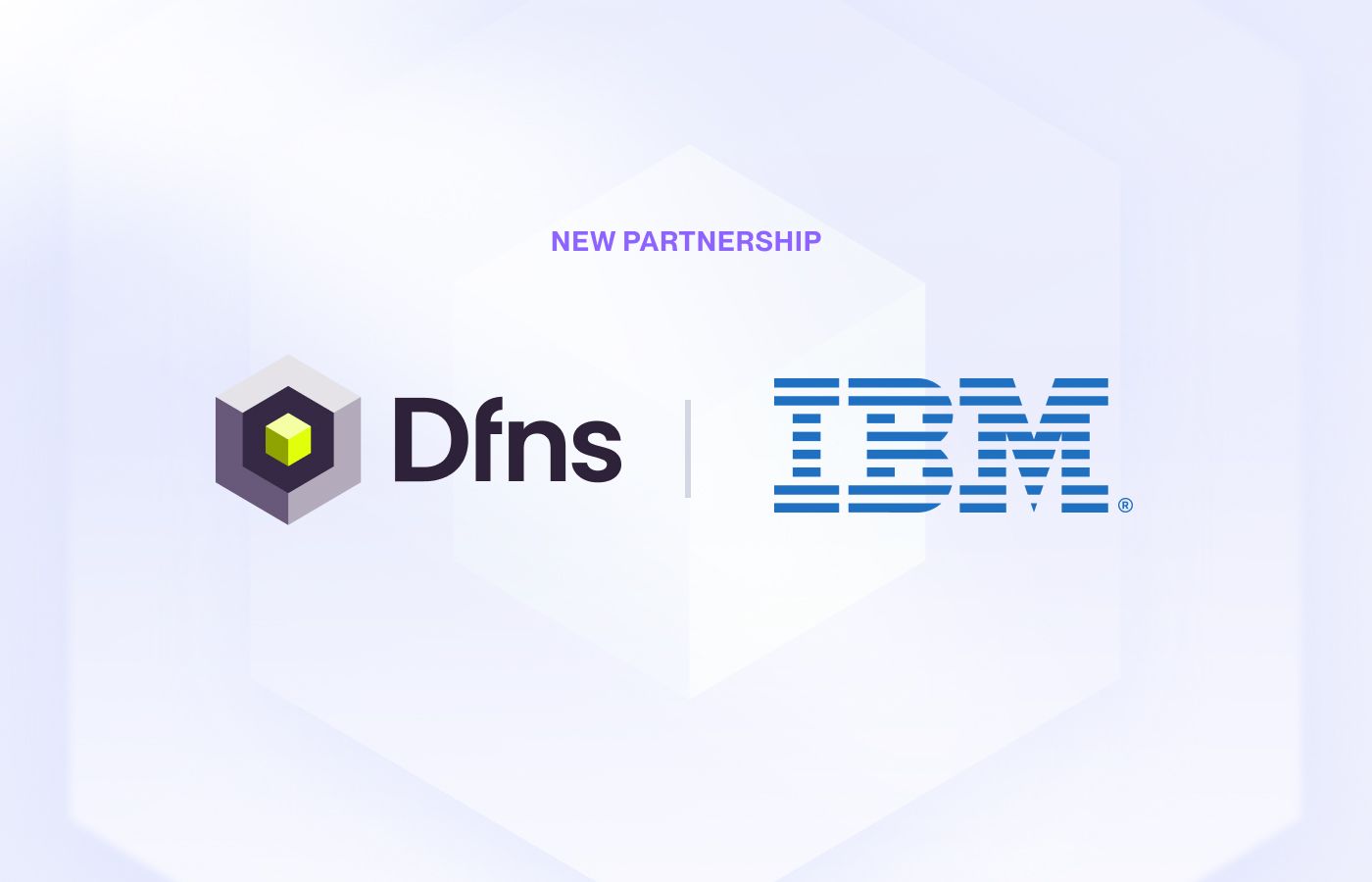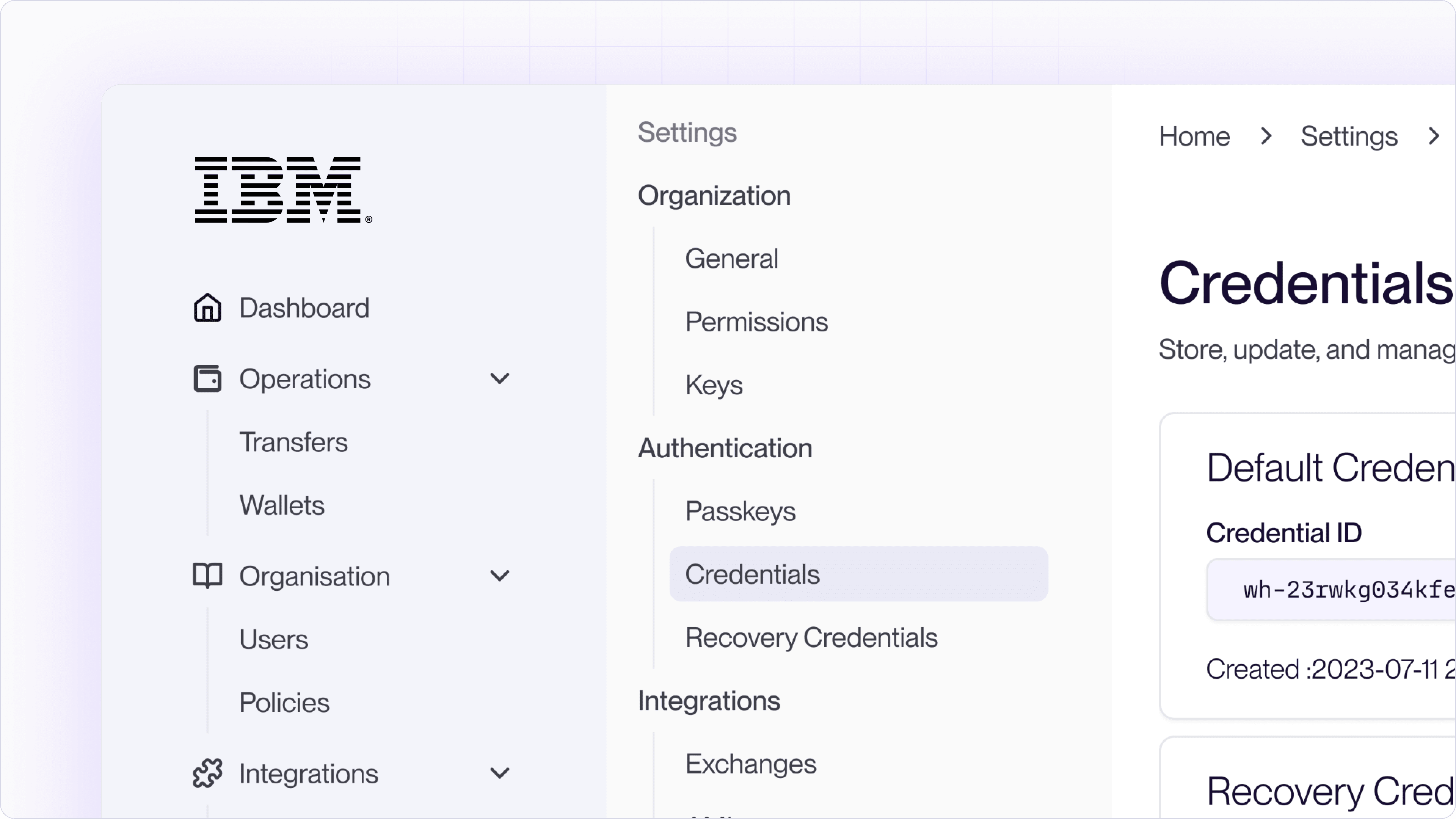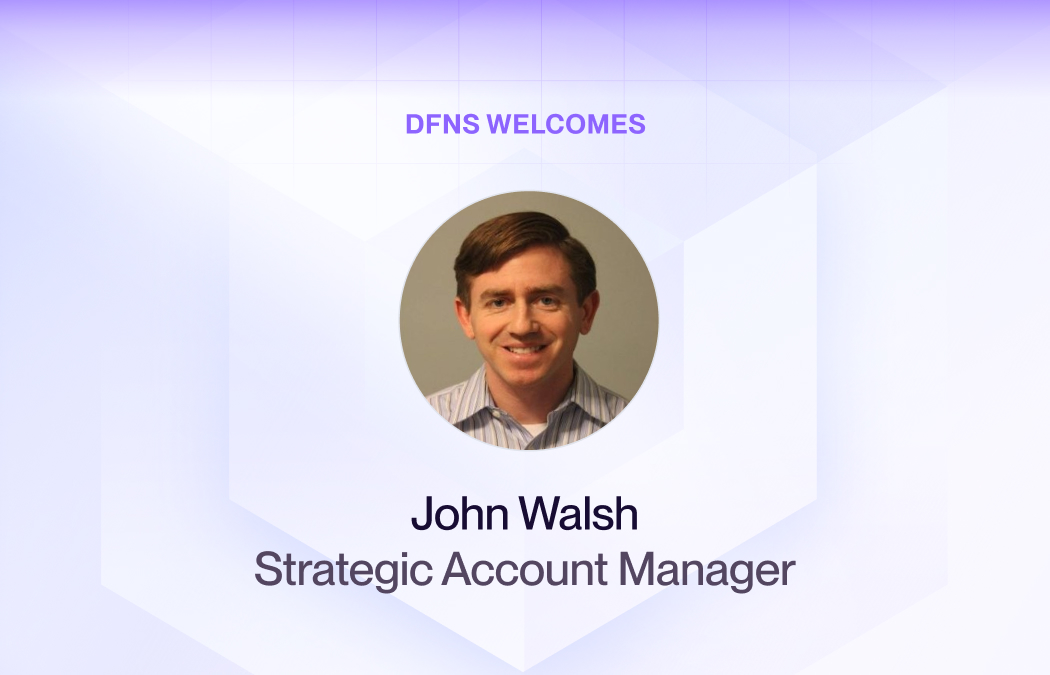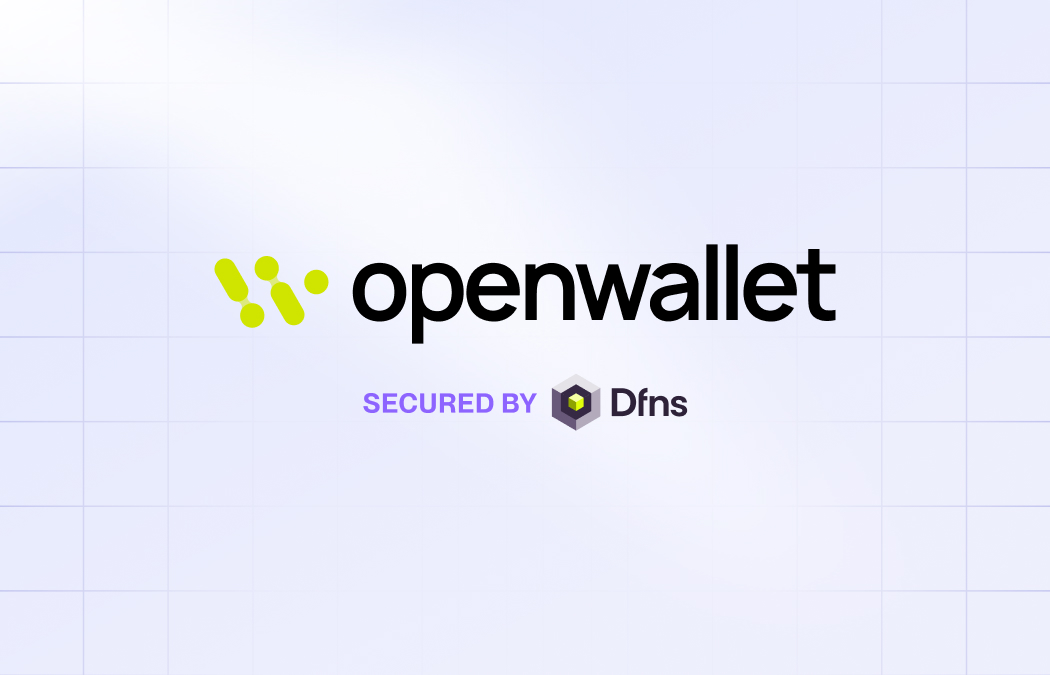
IBM chooses Dfns to power the next era of institutional blockchain infrastructure.
After years of building quietly and often against the tide, we’re proud to announce that Dfns has collaborated with IBM to power their new blockchain wallet infrastructure. As we were writing these words, we thought it was difficult to overstate what this meant, both for us and for the financial industry at large. IBM is IBM. It’s not just another technology firm. It’s one of the great institutions of the modern world. They enable most of what we take for granted today. Roughly 70% of the world’s transactions go through IBM mainframes. For more than a century, IBM has played a defining role in shaping human progress in the digital age.
This is why today feels both surreal and tremendously meaningful. Because when a company of this magnitude decides to make blockchain a strategic priority, it isn’t following the trend—it’s setting it. And that changes everything.
Resilience, reinvention, and the builders who stayed
Six years ago, when we started Dfns, the world of crypto looked very different. It was full of energy and contradictions. Some called digital assets the future of finance, others dismissed it as delusional. Many projects launched with ambition, but most vanished.
Since 2019, the industry has been tested over and over again. The first shock came when Facebook’s Libra, aiming to create a global digital currency, was shut down before it could even launch. Regulators stepped in, tokens were delisted, and global markets split between those who chose to embrace novelty, and those who chose to retreat.
But builders kept building. Developers kept experimenting with decentralized finance and stablecoins. By 2021, the air was electric again. Valuations soared, NFTs broke into the mainstream, and the metaverse became the word of the moment.
Then 2022 took a downturn. Each challenge and setback revealed how fragile the foundation of our young industry still was. And the shock didn’t stay inside crypto. The liquidity crisis rippled outward into traditional finance. After FTX, Silvergate closed its doors. Signature Bank too. Days later, Silicon Valley Bank went bankrupt in a matter of days. Suddenly, the connection between crypto and the global economy became impossible to ignore.
In 2023, the mood was terrible. Liquidity vanished. Valuations dropped. The noise faded. What remained were the builders in the shadows, those still writing code, still believing in the long arc of innovation. Dfns was among them. We endured the cycle, made hard decisions, adapted, and built better. Not because it was fashionable or easy, but because the underlying idea was too powerful to abandon.
The idea that ownership, identity, and value could be managed through code, secured by mathematics, not intermediaries, is one of the most important technological shifts of our time. It is the logical next step in the evolution of trust and infrastructure. For years, we had to explain why infrastructure mattered. Why key management was not a footnote, but the foundation. Why cryptography was the real innovation. Why compliance and transparency could coexist. It was slow work, the kind that only deep conviction sustains. Thankfully, time has a way of clarifying what matters. Today, that time has arrived.

IBM, the company that built the digital world
The International Business Machines Corporation (NYSE: IBM) is foundational to information technology. They’ve invented, developed and maintained systems that allow societies to function. It’s an institution that has witnessed the entire evolution of computing and shaped every single generation of it. From mainframes to cloud, storage, and AI, IBM has always stood at the point where tech meets trust.
They built the first programmable computer in 1944 and introduced the mainframe in 1952. They created the magnetic stripe on credit cards, the UPC barcode, and the hard disk drive. They helped land Apollo 11 on the moon. They invented relational databases, speech recognition, and the RSA algorithm’s first practical applications. The company has produced six Nobel Prizes, thousands of patents every year, and more than one hundred thousand active researchers and engineers.
In the world of security, IBM has been a restless first mover. They designed the Data Encryption Standard (DES) in the 1970s, laying the foundation for modern cryptography. IBM remains one of the world’s largest employers of cryptographers and cybersecurity experts, protecting more than 30,000 global clients and managing over one trillion security events each month. Its X-Force team tracks global cyber threats in real time across every major industry.
In artificial intelligence, IBM created Watson in 2011, which famously defeated every human champion on "Jeopardy!" and opened a new era in applied machine learning. Today IBM watsonx is used by thousands of enterprises to automate decision-making and accelerate research across data-sensitive industries such as finance, healthcare, defense and governments. In quantum computing, IBM was the first to make quantum systems accessible over the cloud in 2016. It now operates one of the largest quantum fleets in the world, with more than 100 qubits available to researchers and developers, and plans to reach a thousand-qubit system in the coming years.
As a business and consulting powerhouse, IBM works most of the world’s top banks, and Fortune 500 companies. Its Infrastructure, Software, and Consulting divisions employ hundreds of thousands of specialists in cybersecurity, AI, and digital transformation. They process millions of mission-critical workloads every day for clients across the world. And behind every transaction there are layers of risk assessments, legal reviews, compliance checks, operational controls, and security measures.
With IBM integrating our technology as their new blockchain infrastructure platform, institutions now have a safe and trusted way to switch on blockchains. They can do it within the same compliance, security, and governance perimeter they already rely on and operate in. The barriers that once slowed adoption are finally disappearing. Blockchains are no longer just for startups or early innovators, they’re entering the mainstream and becoming part of the global technology infrastructure that powers the digital world.

IBM Digital Asset Haven, the new standard for blockchain infrastructure
At the core of the software within IBM Digital Asset Haven lies Dfns, the new generation of secure and programmable digital asset infrastructure. Over the past year, Dfns and IBM have worked closely to integrate this technology with IBM’s most secure environments and components, including Hyper Protect Virtual Servers (HPVS), Offline Signing Orchestrator (OSO), and Hardware Security Modules (HSM). The result is not just an operating system for blockchain finance, unifying custody, transaction orchestration, governance, and third-party service integration under one resilient platform. IBM is giving financial institutions a secure and scalable path to manage digital assets within a security perimeter they already trust.
Dfns’ Wallets as a Service (WaaS) forms the software foundation of IBM’s new platform. It already powers over 15 million wallets across 50 public and private blockchains for more than 250 clients globally. Institutions can issue, monitor, and control wallets through programmable APIs, enabling a wide spectrum of use cases from banking and payments to trading, tokenization, and settlement. Every operation, from key creation and policy enforcement to transaction broadcasting, is accessible through unified interfaces, making the system fully automatable and integrable into existing enterprise workflows.
Within WaaS, the Transaction Management System (TMS) and Wallet Entitlement Management (WEM) form the platform’s operational and governance backbone:
- TMS manages the full lifecycle of blockchain transactions: formatting, signing, routing, batching, rebroadcasting, and settlement, with redundancy and observability across more than 50 connected chains, achieving near zero failure rates.
- WEM enforces granular identity and access management (IAM), PKI-based authentication, multi-party approvals, and policy- and role-based access control, ensuring every action is auditable and compliant with internal risk frameworks.
The Third Party Integrations layer of Dfns’ WaaS extends IBM Digital Asset Haven beyond custody by connecting it to an expanding ecosystem of financial services. It offers a single gateway to integrate third party applications for compliance, payments, trading, market data, settlement networks, and more. This modular model lets institutions compose their own vendor ecosystem around IBM Digital Asset Haven, a unifying operating system that addresses lock-ins and fragmentation, and accelerates go-to-market and time-to-certification.
IBM Digital Asset Haven’s distributed architecture is built to deliver high throughput, sub-second signing, and geo-redundant availability for mission critical financial operations. It scales to manage billions in assets, supports real time batching, and maintains continuous uptime across global data centers.
The security of IBM Digital Asset Haven is enforced through a Zero Trust architecture, providing end-to-end data integrity so no single device, system, or user can move assets alone. Through its Key Deployment Service (KDS), IBM Digital Asset Haven supports multiple cryptographic models including Multi Party Computation (MPC), HSM based signing via IBM Crypto Express 8S, and confidential computing environments such as HPVS and Secure Execution for Linux. Deployments can span hot, warm, or cold environments, with full lifecycle management for key generation, rotation, and recovery.
All Dfns WaaS components are SOC 2 Type II and ISO 27001, 27017, and 27018 certified, with a perfect record of zero breaches or key losses since inception. The platform is designed around compliance and flexibility, supporting FISMA, DORA, and GDPR requirements, and offering SaaS, hybrid, or on premise deployment models. Institutions can bring their own keys using HSMs from IBM or other providers, and can deploy in Trusted Execution Environments (TEE) or Confidential Computing services, ensuring that even privileged administrators cannot access private keys or sensitive processes.
Today, blockchains are crossing the chasm of credibility
For more than a decade, the industry has lived in a credibility gap, strong in innovation, weak in institutional trust. IBM Digital Asset Haven, with a mature blockchain offering, is designed to close that gap. A company relied upon by banks, governments, and critical industries now views blockchain not as an experiment, but as infrastructure ready for global deployment.
This changes the calculus for everyone. Regulators gain a clear benchmark for what compliant blockchain operations look like. Auditors can finally map digital asset systems to established enterprise controls. Executives, long hesitant, now have the confidence to invest, knowing the same company that secures the world’s mainframes is now securing distributed ledgers.
To understand the magnitude of this, consider what IBM represents inside a large institution. The technology stack of a major bank is among the most complex systems ever built, with hundreds of teams, thousands of integrations, and decades of legacy dependencies. Changing even a small part of it can ripple across the entire organization. IBM brings alignment across silos, ensures resilience, and offers enhanced continuity. BCP/DRP compliance frameworks, security, and support are not afterthoughts at IBM—they are the product itself.
For years, we believed that startups like Dfns could sell directly to banks and financial institutions. We had the technology, the expertise, and the conviction. But we underestimated what it truly means to operate within a bank’s risk perimeter. No matter how advanced the cryptography or how strong the engineering, a startup is still a startup, subject to volatility, funding cycles, and limited liability. Large institutions cannot expose their core operations to that level of uncertainty. This partnership changes the dynamic completely.
Since January, our teams have worked side by side with IBM engineers to merge cryptography, compliance support, and infrastructure into one coherent stack. Each challenge forced us to define, line by line, what enterprise grade blockchain infrastructure actually means, from service availability and key orchestration to data governance, auditability, and failover design. The outcome is not a proof of concept, it is a system ready for production at global scale.
IBM brings more than reputation. They bring a 114 year discipline in systems thinking, a philosophy of how technologies evolve, scale, and endure. This mindset built the mainframe, the relational database, and the cloud. Now, that same mindset is being applied to blockchain. And when that happens, the conversation shifts: fewer whitepapers and slogans, more working systems and standards. The next phase for blockchain is not about proving that it works. It is about proving that it integrates, that it can plug into banking systems, risk engines, compliance frameworks, and audit trails with the same reliability as traditional IT. IBM’s involvement makes that future a real possibility.
Where this puts Dfns in the new stack of finance
For Dfns, this partnership is both a deep source of pride and a clear validation of years of quiet, disciplined work. Being selected by IBM, after a long, technical evaluation among every major provider in the market, as the most secure, battle-tested, and bank-grade wallet infrastructure is a massive endorsement and a very satisfying proof that the industry has matured to a point where the quality of engineering, reliability, and security define the winners.
Behind this moment lies years of patient, unseen effort. Endless design iterations. Cryptographic reviews that questioned every assumption. Security audits and compliance exercises that left no detail unchecked. Performance tests that ran until failure, and then ran again. Dfns was built the hard way, with reliability as the first principle, flexibility as the second, scalability as the third. That hierarchy became our advantage. It is what allowed us to meet IBM’s standards and stand out in the selection process.
Some might think we’ve created a competitor to ourselves. We do not see it that way. From the beginning, we understood that no single company in blockchain could bring the world's largest financial institutions into production at global scale. That requires the reach, scalability, trust, and operational rigor of a company like IBM. What we have created together is not competition, it’s unequaled distribution for blockchain technology.
Dfns remains an independent company, and that independence remains essential. We will continue to build, maintain, and grow our own platform with speed and conviction. The version of our technology that will run on IBM Cloud, on LinuxONE and IBM Z systems, will evolve on its own trajectory. IBM will shape it for its enterprise clients, while we continue to develop features in parallel, sometimes for other markets and audiences, such as fintechs, payment platforms, and developer ecosystems that might not use IBM. Independence ensures that both paths strengthen each other without constraint.
We won’t stop building until the job is done
To our team: Thank you for pushing forward even when the path wasn’t clear. We owe you everything.
To the IBM executives and engineers who held us to the highest standards, your rigor turned collaboration into real progress.
For Dfns, this milestone is the tangible result of our mission. For the industry, it’s proof that blockchain has joined the financial main stack. And this is just the beginning.
- Full press release: https://newsroom.ibm.com/ibm-digital-asset-haven
- IBM Digital Asset Haven: https://www.ibm.com/products/digital-asset-haven
- Bloomberg: https://www.bloomberg.com/news/articles/2025-10-27/ibm-launches-digital-assets-platform-as-crypto-activity-jumps
- Blockworks: https://blockworks.co/news/ibm-dfns-blockchain




